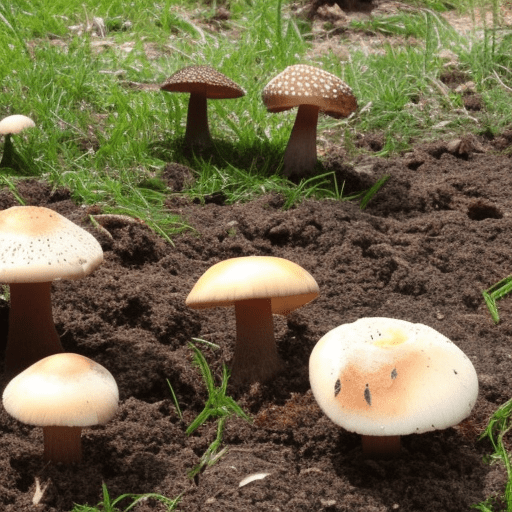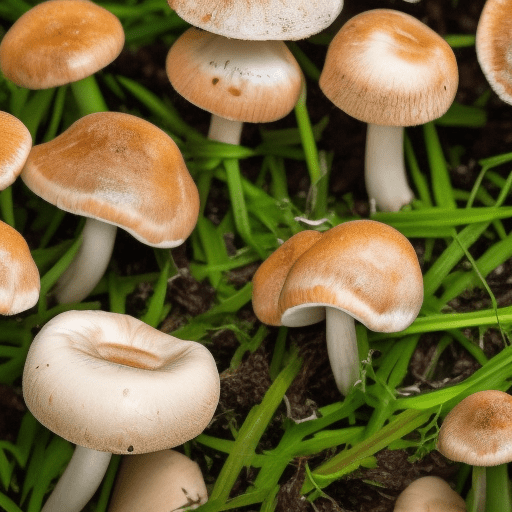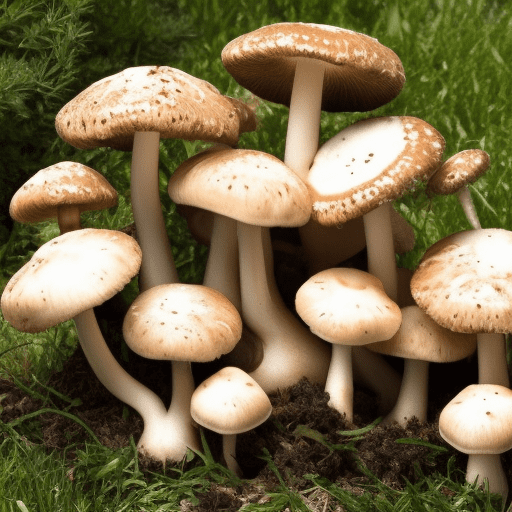Why Do Mushrooms Grow In My Yard: A Fungus Exploration
Seeing mushrooms growing in your yard can be a bit freaky, especially if you have pets or little brothers and sisters running around. But don’t stress, there’s probably a simple reason for it!
Most of the time, fruiting bodies like mushrooms just mean your lawn is healthy and has lots of organic materials in it. Mushrooms are like the tip of the iceberg. They show that there’s a ton of microbial activity doing their thing underground, which is awesome for your soil health!
This is especially true when you have organic matter like old leaves and plant roots breaking down in the ground.
Let’s find why these wild mushrooms are popping up in your yard! We’ll look at lots of kinds, such as the common mushrooms like white button mushrooms you see at the store. We’ll even cover weirder ones like shiitake mushrooms and king oyster mushrooms.

Here are 8 common reasons why mushrooms grow in my yard
You may ask yourself, “Why Do Mushrooms Grow In My Yard?” Here are some potential reasons:
- Ideal conditions – Lawns provide shade, moisture and humid conditions that certain mushrooms thrive in. Dew and dampness help all kinds of plant growth, even fungi!
- Nutrients – Decaying grass clippings, mulch, and dead leaves in yard waste provide plenty food for mushroom growth. Fungi eat up these natural materials to grow bigger.
- Mycelium – Mushrooms grow from a hidden web of roots called mycelium in the soil. This network of mycelium is important for the mushrooms to get nutrients and water.
- Spores – Mushroom spores are everywhere and easily spread by wind, rain, animals, lawnmowers, etc. Some mushrooms produce millions of tiny spores. These spores can chill in the soil for a long time until it’s the perfect time for them to start growing.
- Disturbed soil – Digging, mowing, and raking all disturb the soil, which can bring buried mushroom spores to the surface to germinate. This is why you might see mushrooms growing after you’ve been working in your yard.
- Lack of sunlight – Mushrooms love the shade! They grow best under trees and bushes, and the sun stops them from growing.
- Fungi – Your yard is like a mushroom city! Tons of fungi live there, and they love damp places so they can spread and make more mushrooms. These fungi are like tiny recyclers! They munch on dead stuff like organic materials, which assists in improving soil health.
- Seasons – Mushrooms thrive mainly in spring through fall when weather conditions are damp, humid and moderate in temperature.
If you’ve been having particularly wet weather recently, this could cause these fungi to start growing in your yard.
Most yards have the perfect mix of shade, water, and nutrients that mushrooms love. Controlling their growth can be difficult.
Explain it to a child
Mushrooms are a type of fungus. Many reasons can make mushrooms grow in your yard, like lots of water, shade, or just the right temperature and soil.
You’ll also find mushrooms hanging out where there’s lots of natural stuff like dead leaves or soil nobody’s messed with.
Whatever the cause may be, one thing is certain: you have dozens of mini gardens sprouting up all over your lawn!
What causes mushrooms to grow in my yard?
- Those pesky mushrooms thrive in situations with abundant moisture. Rainwater or water from a sprinkler is perfect for their growth.
- Plus, if the temperature remains around 55-70 degrees Fahrenheit, it’s a near-perfect temperature environment for mushroom spores.
- The source of the fungi could be a nearby mature tree, since mushrooms feed off decaying matter.
What’s more, these fleshy fungi mostly hide away in the dark, they still need a little bit of light to start growing.
What could it mean when mushrooms grow in My yard?
Mushrooms are a sign of healthy soil and grow in damp areas.
They need the right amount of water and nutrients to stay alive and grow.
What’s more, mushrooms are great for your garden as they absorb toxins from the environment and help fertilize the ground.
You might not think mushrooms are a good thing, but they can actually show you how to take better care of your yard!
Can I eat the mushrooms that grow in My yard?
Erring on the side of caution is a safer bet with wild mushrooms.

Don’t eat wild mushrooms unless you’re a mushroom expert! Best to be safe and just avoid them.
If properly identified, certain edible mushrooms found in backyards might offer nutritional and culinary benefits. But watch out! Lots of poisonous mushrooms look a lot like the ones you can eat.
If you pick wild mushrooms, have an expert check them out before you eat them!
Are the mushrooms in my yard poisonous?
Mushrooms can be extremely difficult to identify accurately. Some mushrooms look almost the same, but have different levels of toxic parts. Even experts can make mistakes identifying capped mushrooms!
Always think a mushroom is poisonous until someone who knows about mushrooms says it’s okay. This is especially true for brown mushrooms, which can be particularly difficult to identify.
A smart move is to exercise caution and remove any wild mushrooms you find. This keeps your family and pets safe from any poisons. Remember, even a small amount of some mushrooms can be deadly.
How to know if mushrooms are good to eat or not?
Deciding whether or not to eat a mushroom can be challenging. It can be hard to tell mushrooms apart because some look alike but can be super poisonous. The good news is there are some easy ways to figure out if a mushroom is safe to eat.
First, do your research and find the common characteristics of edible mushrooms. Avoid any that don’t fit those descriptions. For example, learn to identify popular edible species like portobello mushrooms, baby bellas, and white mushrooms.
Second, look for signs of active decay of plant matter and throw away any mushrooms that appear wilted or slimy.
Lastly, purchase from reputable sources such as grocery stores, farmers’ markets, and mushroom farms. If you’re looking for mushrooms to use in stir fries or other dishes, it’s best to buy them from a reliable source.
If followed correctly, these steps can help you to know if the mushrooms on your plate are good to eat or not.
How to remove mushrooms from my yard?
Removing mushrooms from your yard can be easier than you might think. Just yank those mushrooms out of the ground! But there are other ways to do it, too.

You can use special mushroom-killing sprays for large areas or just on single mushrooms. These sprays get into the roots and kill the whole mushroom.
You can also try to stop mushrooms from growing by cleaning up your yard and adding mulch.
These methods work best after it rains a lot because the ground is wet and soaks up the treatments better.

Conclusion: Why do mushrooms grow in my yard?
So, the next time you spot some funky fungi popping up in your yard, don’t freak out! Mushrooms are usually a sign that your lawn is happy and healthy.
They’re like little reminders that there’s a whole hidden world beneath our feet. A world full of tiny organisms working hard to keep things balanced. And who knows, maybe with a little help from an expert, you might even discover some tasty treats hiding in your backyard!
Just remember to be cautious and always double-check before you decide to sample any wild mushrooms.
Article Sources
Jacks of Science sources the most authoritative, trustworthy, and highly recognized institutions for our article research. Learn more about our Editorial Teams process and diligence in verifying the accuracy of every article we publish.
